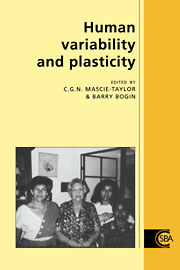Book contents
- Frontmatter
- Contents
- List of contributors
- Foreword
- 1 The pervasiveness of plasticity
- 2 Plasticity in early development
- 3 Plasticity in the growth of Mayan refugee children living in the United States
- 4 The place of plasticity in the study of the secular trend for male stature: an analysis of Danish biological population history
- 5 Plasticity, growth and energy balance
- 6 The study of migrants as a strategy for understanding human biological plasticity
- 7 Human migration: effects on people, effects on populations
- 8 The use of surnames in the study of human variation and plasticity
- 9 A biological anthropological approach to measuring societal stress of parasitic disease: a case study of schistosomiasis
- 10 Biological adaptability, plasticity and disease: patterns in modernizing societies
- 11 Human biological adaptability with special emphasis on plasticity: history, development and problems for future research
- Index
2 - Plasticity in early development
Published online by Cambridge University Press: 28 October 2009
- Frontmatter
- Contents
- List of contributors
- Foreword
- 1 The pervasiveness of plasticity
- 2 Plasticity in early development
- 3 Plasticity in the growth of Mayan refugee children living in the United States
- 4 The place of plasticity in the study of the secular trend for male stature: an analysis of Danish biological population history
- 5 Plasticity, growth and energy balance
- 6 The study of migrants as a strategy for understanding human biological plasticity
- 7 Human migration: effects on people, effects on populations
- 8 The use of surnames in the study of human variation and plasticity
- 9 A biological anthropological approach to measuring societal stress of parasitic disease: a case study of schistosomiasis
- 10 Biological adaptability, plasticity and disease: patterns in modernizing societies
- 11 Human biological adaptability with special emphasis on plasticity: history, development and problems for future research
- Index
Summary
He who sees things grow from the beginning will have the best view of them.
AristotleSummary
Lasker (1969) identified three levels at which species undergo environmental adaptation: selection of appropriate genotypes, phenotype modification during ontogeny, and behavioural or physiological responses by fully formed individuals. This chapter deals mainly with the second of these and addresses recent evidence that both supports and challenges contemporary beliefs.
The potential for expression of an entire genome is initially a property of most cell types, but as ontogeny proceeds cells and tissues gain or lose competence to respond to embryonic inducers, they acquire programmes for future gene expression and are said to become determined. The physiological properties, relative positions and volumes of tissues are defined only roughly by the genome, their finer details resulting from responses to mutual metabolic and physical interactions. Within cell groups the plasticity of individual cells becomes overwhelmed by common aspects of metabolism, the Leader Cell Hypothesis and the Community Effect being attempts to elucidate the basis of this coordination.
As cytodifferentiation proceeds, specific patterns of methylation of cytosine residues arise along the chromosomes, while acidic proteins and modified histones associate with the DNA in the vicinity of those genes concerned with specialized functions. The specialized properties of tissues seem, however, to be controlled more by cytoplasmic than by nuclear factors. The immune system behaves in an exceptional fashion, the system as a whole finally acquiring an exquisite degree of plasticity although individual cells suffer irremediable loss and rearrangement of gene segments that ensures each clone can synthesize only one type of antibody molecule.
- Type
- Chapter
- Information
- Human Variability and Plasticity , pp. 18 - 45Publisher: Cambridge University PressPrint publication year: 1995
- 2
- Cited by



